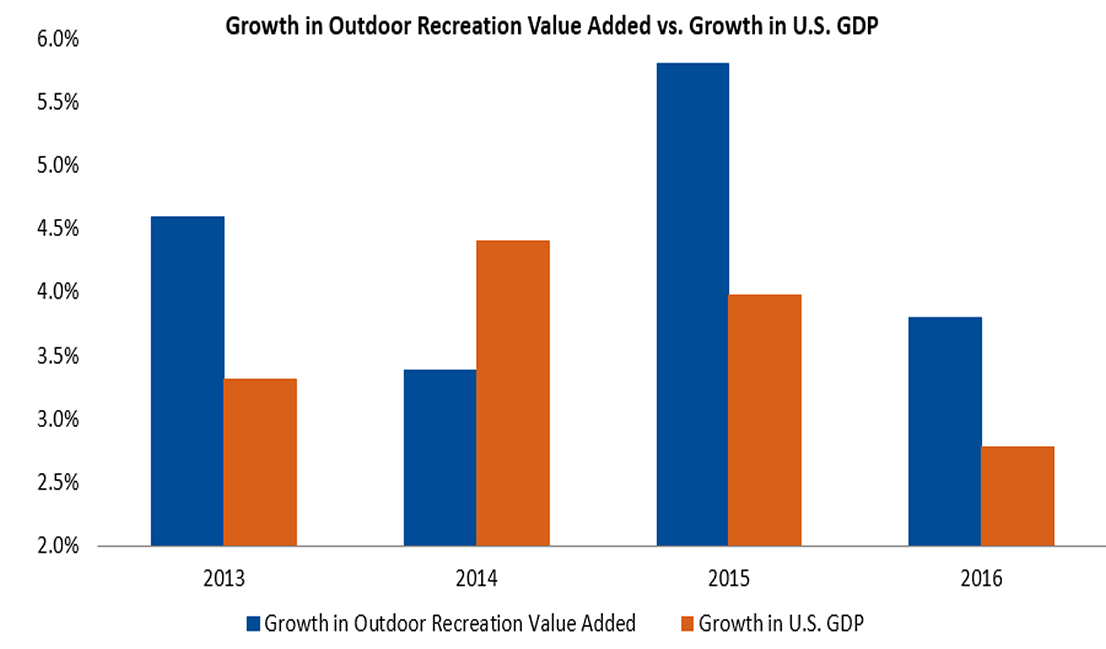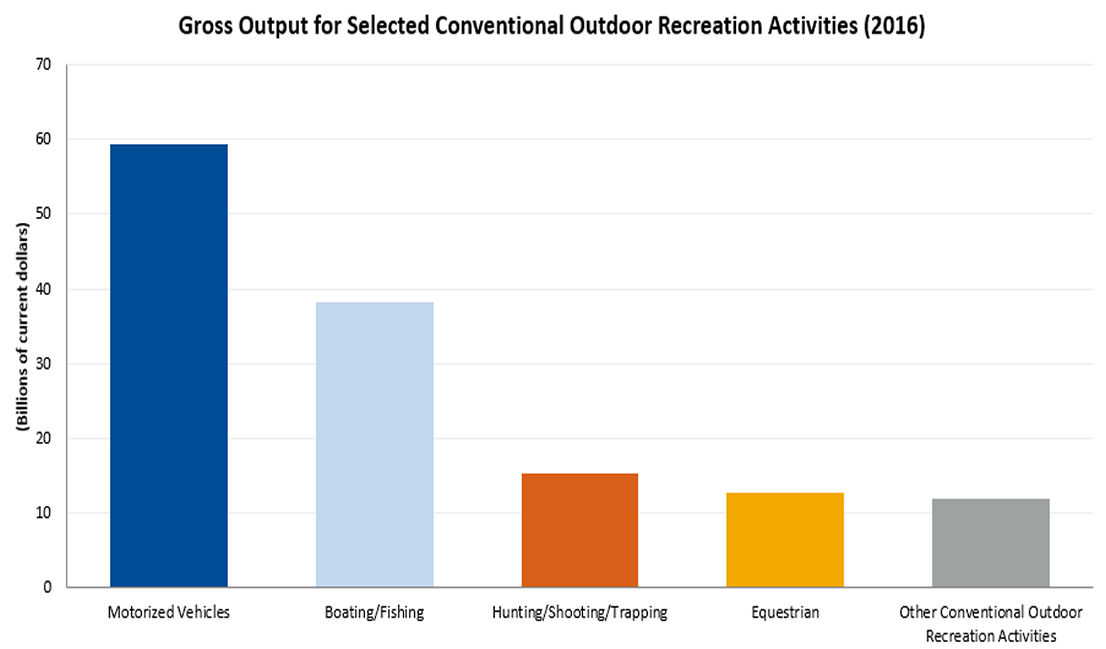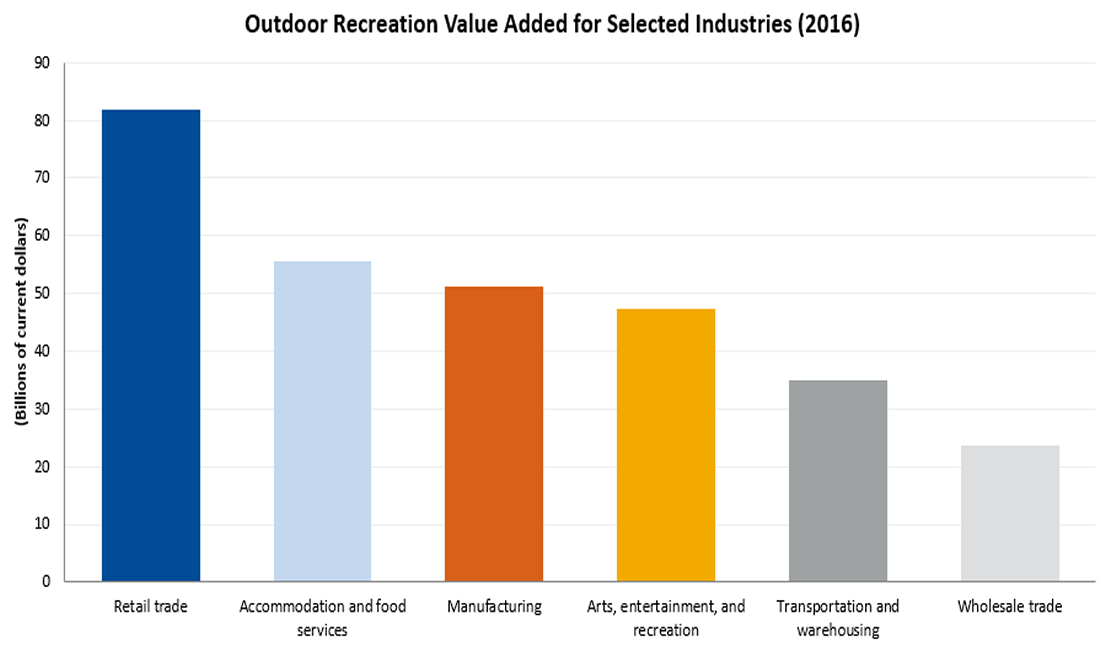News Release
Outdoor Recreation Satellite Account, Prototype Estimates, 2012-2016
Outdoor recreation accounts for 2.0 percent of GDP in 2016
Prototype statistics from the Outdoor Recreation Satellite Account (ORSA) released today by the U.S. Department of Commerce's Bureau of Economic Analysis (BEA) show that the outdoor recreation economy accounted for 2.0 percent ($373.7 billion) of current-dollar GDP in 2016 (table 1). In addition, the outdoor recreation economy grew 3.8 percent in 2016, compared to growth of 2.8 percent in the overall economy.
"Businesses need the right data to help them hire, invest and grow. The historical lack of detailed federal data regarding outdoor recreational activities has handicapped both the private and public sectors. The public will no doubt be surprised at the economic importance of this industry as we release prototype statistics measuring the impact of activities like boating, fishing, RVing, hunting, camping, hiking, and more. This release is a milestone for business executives, small-business owners, entrepreneurs, and government officials, who will rely on these detailed data to plan, grow, and gain new insights into this dynamic part of the U.S. economy," said U.S. Commerce Secretary Wilbur Ross.

The new account is the latest addition in a series of satellite accounts complementing BEA's statistics, including accounts on travel and tourism and arts and cultural production. These accounts do not change BEA's official statistics, including GDP. They provide greater detail and allow closer analysis of a specific area of the economy by extracting information embedded in the official economic statistics.
Outdoor Recreation by Activity
In the Outdoor Recreation Satellite Account, gross output—principally a measure of sales or receipts associated with the outdoor recreation economy—is presented both by industry and by outdoor recreation activity. Outdoor recreation activities fall into three general categories: conventional core activities (including activities such as bicycling, boating, hiking, and hunting), other core activities (including activities such as agritourism and outdoor festivals), and supporting activities (including construction, trips and travel, and government). In 2016, conventional recreation accounted for 36.7 percent of total outdoor recreation gross output, other recreation accounted for 22.1 percent, and supporting activities accounted for the remaining 41.2 percent (table 2).

- Motorized Vehicles was the largest activity within conventional outdoor recreation in 2016, accounting for $59.4 billion of gross output. Recreational vehicles accounted for more than half of this value at $30.0 billion.
- Boating/Fishing activities were $38.2 billion in 2016, an increase of 4.0 percent from the previous year.
- Hunting/Shooting/Trapping activities were $15.4 billion in 2016, with hunting accounting for over 60 percent of this value.
- Multi-use apparel and accessories, which include backpacks, bug spray, and other general-purpose gear and accessories that could not be allocated to specific activities, grew 7.2 percent in 2016 and accounted for 35.0 percent of conventional outdoor recreation gross output.
Outdoor Recreation by Industry
Outdoor recreation value added is presented by industry in the ORSA and shows how an industry's participation in the outdoor recreation economy contributes to GDP. For example, the data show that the retail trade, accommodation and food services, and manufacturing industries were the largest contributors to the outdoor recreation economy in 2016, accounting for half of all outdoor recreation activity (table 1).

- For the retail trade industry, outdoor recreation value added was $81.7 billion and accounted for 21.9 percent of all activity in the outdoor recreation economy.
- Outdoor recreation value added was $55.7 billion in accommodation and food services, with about 63 percent of this value coming from accommodations and 37 percent from food services and drinking places.
- Outdoor recreation value added for manufacturing was $51.3 billion, primarily reflecting activity in the subcategories of petroleum and coal products and other transportation equipment.
- Outdoor recreation value added was $47.4 billion in arts, entertainment, and recreation and accounted for 24.7 percent of that industry's total value added.
Public comment and feedback
The public is invited to submit comments and feedback on these preliminary statistics by emailing OutdoorRecreation@bea.gov. Final statistics are scheduled for release in the fall of 2018, and feedback will be used to help finalize the definitions, data sources, and methodology that underpin the new account and the format in which final results are displayed. To ensure consideration, comments should be submitted no later than April 27, 2018.
The Outdoor Recreation Satellite Account (ORSA) measures the size of the outdoor recreation economy and the link between outdoor recreation and the broader United States economy. Like other satellite accounts, the ORSA was built on BEA's comprehensive supply-use framework. The supply-use tables provide a detailed look at the relationships among industries and how each industry contributes to Gross Domestic Product (GDP). In practice, the ORSA is a rearrangement of the published supply-use tables that isolates outdoor recreation spending and production. For example, the supply-use tables show the production of all apparel, whereas the ORSA shows the production of apparel used specifically for outdoor recreation activities, such as wet suits and hiking boots. A variety of private and public data sources were used to identify outdoor recreation spending and production in order to develop the prototype ORSA estimates.
The term "outdoor recreation" can be defined in many different ways. BEA staff worked closely with outdoor recreation experts from academia, government, and industry to develop the definition of outdoor recreation used in the ORSA. To meet the needs of diverse data users, the definition and presentation of statistics used in the prototype account are designed to capture both the conventional and broad views of outdoor recreation reflected in existing literature. The conventional definition reflects more traditional outdoor recreation activities such as hunting, hiking, camping, and fishing. More formally, the conventional definition includes all recreational activities undertaken for pleasure that generally involve some level of intentional physical exertion and occur in nature-based environments outdoors. The broad definition includes all conventional outdoor recreation activities and a range of additional activities. More formally, the broad definition includes all recreational activities undertaken for pleasure that occur outdoors.
The ORSA follows other BEA satellite accounts by dividing outdoor recreation activity into two general categories: core and supporting. Core activities include the production and purchase of goods and services used directly for outdoor recreation, while supporting activities are defined as goods and services that support access to outdoor recreation activities. Core activities for the ORSA include the production and purchase of gear, equipment, fuel, concessions, maintenance, repair, and fees. Supporting activities include trip expenses, construction, and government expenditures related to outdoor recreation activities.
An important feature of the ORSA is the presentation of gross output estimates by type of outdoor recreation activity, in addition to the standard presentation of estimates by industry. Due to overlap among many outdoor activities (for example, hiking while camping or fishing while boating), activities were either split into mutually exclusive categories when source data allowed or combined into a single category containing multiple related activities. For example, camping and hiking were combined into a single category to avoid double counting the many items that can be used for both activities.
The final ORSA report is scheduled for publication in the fall of 2018 in response to the requirements of the Outdoor Recreation Jobs and Economic Impact Act of 2016, which directed the Secretary of Commerce to "enter into a joint memorandum with the Secretary of Agriculture and the Secretary of the Interior to conduct, acting through the Director of the Bureau of Economic Analysis, an assessment and analysis of the outdoor recreation economy of the United States and the effects attributable to such economy on the overall economy of the United States."
Additional information on the outdoor recreation statistics and the data sources and methodology that underlie their preparation will be available in the March 2018 issue of the Survey of Current Business.